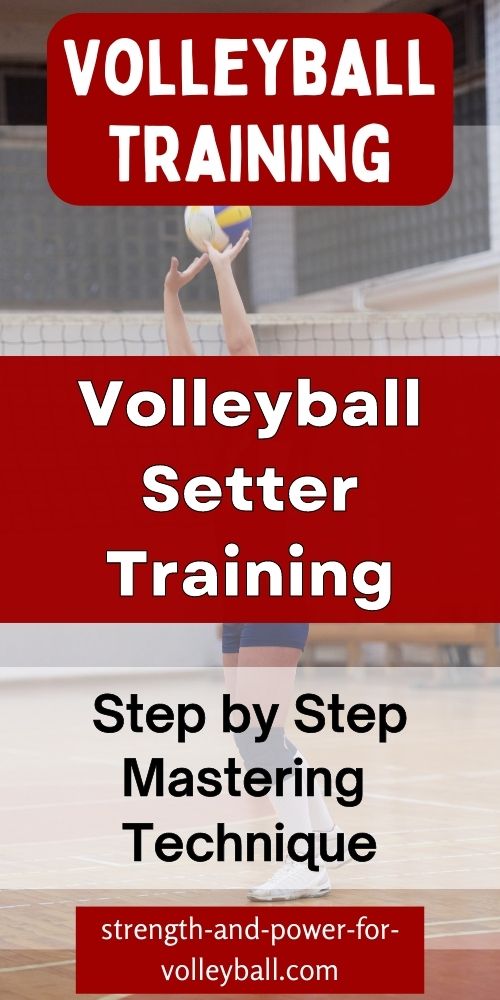Volleyball Setter Training
How to Become an Awesome Setter
Volleyball setter training is a must for any setter that wants to compete at a high level. Here is a setter training guide to help you improve your setting skills so you can become a really good setter.
Hand Set Technique - Volleyball Setter Training
The first thing to focus on is the hand setting technique. You want to develop a consistent hand setting motion. If you are consistent with how you set the ball, you will be more accurate and consistent with where you place your sets.
Focus on maintaining the same hand position throughout the motion. When you set, record your technique on video or have a coach give you feedback. Watch for the position of the hands at pre-contact and post-contact. The position of the hands should be the same before you contact the ball and after you release the ball.
Also, focus on getting all 10 digits on the ball. You don't want to be contacting the ball more on one hand than the other. You want a symmetrical contact of all 10 digits.
To set the ball farther and faster, focus on using more hands, fingers, and wrists and not so much arms. Your setting drills should involve the setting motion that avoids bending the elbows.
The contact position is also very important. Contact the ball high and keep the ball high. This will help you set the ball faster and farther.
Footwork - Volleyball Setter Training
Footwork is the part of setting that most people overlook. The feet are critical because having good footwork will allow you to get in good position to set. If you aren't good at getting in position, then you won't be a good setter.
There are footwork patterns for different situations.
For example, there's different footwork for the coming off the net to set vs setting a ball that is passed directly to you at the net.
How you move your feet as you are about to set the ball will help you get in a good position to set.
Just like you would learn an approach for getting into a good position to spike a volleyball, you need to learn footwork for getting in position to set a volleyball.
Good footwork helps you get there fast and efficiently. Being successful is all about getting in position. If you can't get there, you can't make the play. So, be sure to learn the footwork and practice executing the correct footwork in game situations.
Clean and Consistent - Volleyball Setter Training
Often a setter will struggle to set the ball far enough to the outside hitter.
A common mistake is to think the setter needs to hold onto the ball longer and push it out of the hands faster.
If you bend the elbows and grab onto the ball, this won't work. This is a mistake because this will slow down the set.
Instead of bending the elbows and catching the ball, the focus should be getting the ball out of the hands faster.
Just like if a hitter will jump higher when they have faster steps when they approach, the setter will set the ball farther when they set faster.
Focus on getting the ball into the hands and out of the hands faster and you will set the ball farther. You won't be able to do this if you have a lot of elbow bend while you set.
Bending the elbows will slow down the setting motion.
Taking the ball high, keeping it high, and focusing on using the wrists to get the ball out of the hands as fast you as you can will help you develop faster hand sets.
Traits of the Best Setters - Volleyball Setter Training
To be a great setter, you need to train like the best setters. Find a really good setter and model them. Model their technique. Model their attitude. Watch how they interact with teammates. Watch how they lead their team.
You'll notice how the best setters have common traits.
There are traits like footwork and setting mechanics, but then there are also personality traits such as how the setter interacts with teammates.
Think about how you set and how you interact with your team. Do you share some of these same character traits?
Think about what you can work on to improve at the setter position.
Being a good setter isn't about talent. Setting is a skill. Everything is just a skill.
Interacting with people is a skill. These are social skills.
If you want to be a great setter competing at a high level, you need to develop these skills. If you put in the time, you will make it happen.
One thing that's definitely common among great setters is they know a lot about how to win. They know all about volleyball.
They know about leadership and how important it is to help lead their team.
Like the coach, the setter must make critical decisions that will determine the outcome of the match.
These decisions will often be the difference between winning and losing. The more the setter understands the game, the better decisions the setter will make.
The better decisions the setter makes, the more successful the team will be.
Since the setter has such a big impact on the game, it's critical the setter takes the time to continue to learn what their team needs to do to play better and win.
If you enjoyed these volleyball setter training tips and would like to keep it close to you at any time, just save this pin to your Pinterest Volleyball Training Board.
- Home
- Techniques
- Volleyball Setter Training
